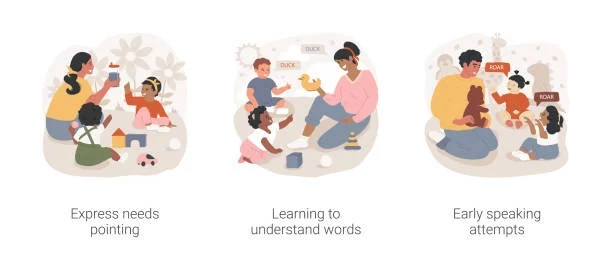Developmental language delays affect approximately 10-15% of children, making early identification and intervention crucial for optimal outcomes. When children struggle with language development, timely and targeted support can significantly impact their communication abilities, academic success, and social-emotional well-being throughout their lives.
Understanding Developmental Language Delays
Developmental language delays encompass difficulties in understanding or using spoken language that cannot be attributed to hearing loss, intellectual disability, or other developmental conditions. Children with these delays may struggle with vocabulary acquisition, sentence formation, following directions, or expressing their thoughts and needs effectively. These challenges often become apparent between the ages of 18 months and 3 years, though some subtle signs may emerge earlier.
The causes of developmental language delays are often multifactorial, involving genetic predisposition, environmental factors, and neurological differences in language processing areas of the brain. Recognizing these delays early allows families and professionals to implement strategies that can help children reach their full communication potential.
The Critical Importance of Early Intervention
Research consistently demonstrates that the earlier intervention begins, the better the outcomes for children with language delays. The brain’s neuroplasticity is greatest during the first few years of life, making this period optimal for language learning and skill development. Early intervention can prevent secondary challenges such as academic difficulties, behavioral problems, and social isolation that often accompany untreated language delays.
Children who receive appropriate support before age three show significantly greater improvements in language skills compared to those who begin intervention later. This early support not only addresses immediate communication needs but also establishes a foundation for future learning and development across all domains.
Family-Centered Approaches
Successful early intervention recognizes that families are children’s first and most important teachers. Family-centered approaches emphasize collaboration between professionals and caregivers, ensuring that intervention strategies are culturally appropriate, practical for daily routines, and sustainable over time.
Parents and caregivers learn to embed language-rich activities into everyday experiences such as mealtimes, bath time, and play. This approach maximizes learning opportunities while strengthening the parent-child relationship. Training family members to use specific communication strategies ensures consistent support across all environments where the child spends time.
Professionals work closely with families to identify priorities, respect cultural values, and build on existing strengths within the family system. This collaborative approach leads to more meaningful and lasting improvements in children’s communication abilities.
Evidence-Based Intervention Techniques
Several research-supported strategies have proven effective for children with developmental language delays. Naturalistic language intervention focuses on following the child’s interests and using everyday activities as learning opportunities. This approach includes techniques such as modeling appropriate language, expanding on the child’s attempts to communicate, and providing meaningful choices that encourage verbal responses.
Interactive book reading represents another powerful intervention tool. Shared reading experiences expose children to rich vocabulary, complex sentence structures, and narrative concepts while providing opportunities for turn-taking and conversation. Professionals often train caregivers in specific questioning techniques and interactive strategies that maximize the language learning potential of reading activities.
Play-based interventions capitalize on children’s natural motivation to engage with toys, games, and social activities. Through carefully structured play experiences, children practice communication skills in enjoyable, low-pressure contexts. These interventions often target specific language goals while maintaining the child’s intrinsic motivation to participate and learn.
Professional Support and Team Collaboration
Early intervention typically involves a multidisciplinary team of professionals working together to address children’s comprehensive needs. Speech-language pathologists play a central role in assessing communication abilities, developing intervention plans, and providing direct therapy services. Given the specialized training required for this profession, the speech language pathology salary reflects the expertise and education necessary to effectively support children with communication challenges.
Other team members may include early childhood special educators, occupational therapists, physical therapists, and developmental pediatricians. This collaborative approach ensures that intervention addresses all aspects of the child’s development while maintaining focus on communication goals.
Regular team meetings and progress monitoring help ensure that strategies remain effective and appropriate as children develop. Communication between team members and families facilitates consistent implementation of intervention techniques across all settings.
Environmental Modifications and Support
Creating language-rich environments significantly enhances intervention effectiveness. This includes reducing background noise, ensuring appropriate lighting for visual communication cues, and organizing spaces to encourage interaction and communication attempts.
Technology can also support language development through carefully selected applications, communication devices, and interactive tools. However, technology should supplement, not replace, human interaction and responsive communication partnerships.
Long-Term Outcomes and Future Success
Early intervention for developmental language delays yields lasting benefits that extend far beyond improved communication skills. Children who receive appropriate support demonstrate better academic performance, stronger social relationships, and enhanced self-confidence throughout their school years.
The investment in early intervention services ultimately reduces the need for more intensive and costly special education services later in life. By addressing language delays promptly and comprehensively, families and communities support children’s long-term success and independence.

Lexy Summer is a talented writer with a deep passion for the art of language and storytelling. With a background in editing and content creation, Lexy has honed her skills in crafting clear, engaging, and grammatically flawless writing.


